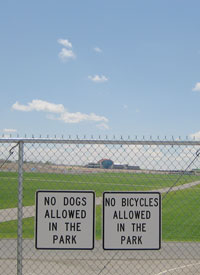For my bike ride this morning, I headed north to check out the new bike path into Albuquerque’s Balloon Fiesta Park, which my colleague Rosalie Rayburn wrote about in this morning’s paper (sub/ad req). We’re a week away from Albuquerque’s famed balloon fiesta. I’ve always enjoyed riding bikes in the mornings and watching a zillion hot air balloons, but the auto traffic around the field itself is a nightmare, so I normally stick to the paved bike trails which go near the balloon field, but not too near.
This year, the newly completed trail goes right up to the balloon field itself – grade separated, zero auto, bikes only. This is great, a real positive step by the city to make one of Albuquerque’s most popular events more bike friendly. I’ve been watching the final construction for months, so I rode up this morning to see if the final bits were done.
When I got close, I found the final half mile still blocked off while workers put the finishing touches on whatever needs finishing. So I followed the old route into the balloon field, which I sadly had to share with large motorized vehicles. As, for example, the guy in the unnecessarily large pickup truck who yelled something to the effect that it would have been more convenient to him were I to have not used this particular road.
It also would have been more convenient to me if he weren’t on the road, but it’s all about sharing the space and trying to get along, right? It never occurred to me to yell at him for taking up so much space with his unnecessarily large pickup truck. But then, I don’t have a big metal cage to protect me from what might follow, so best to just smile and ride defensively.

No dogs or bikes allowed.
When I got to the park’s entrance, where cars were heading in to do whatever it is they were heading in to do, I was stopped by a parking security person. She stepped out into the lane in front of me, waved me down assertively, and said, politely but firmly, “No bikes allowed.”
Sigh. We’re making progress, but we still have a ways to go. (Picture taken three years ago at the far end of the same park. I’m pretty sure the signs are still there.)


